CINAHL Database Search Strategy for Palliative Care in Heart Failure
VerifiedAdded on 2023/06/04
|13
|2471
|443
Report
AI Summary
This report presents a comprehensive exploration of a search strategy designed to identify evidence regarding the efficacy of palliative care for patients with heart failure. The study focuses on developing a PICO question to guide the search process within the CINAHL database, a choice justified by its relevance to healthcare literature. The report details the search strategy, including the use of various keywords, thesauri, and Boolean operators to refine search results. The analysis includes an evaluation of the search outcomes, highlighting the limitations of certain approaches, such as the MeSH option, and the successful retrieval of relevant articles using a combination of search terms and operators. The report concludes by identifying a key research paper that supports the benefits of palliative care in improving outcomes for heart failure patients and acknowledges the need for further research, particularly randomized controlled studies, to strengthen the evidence base.
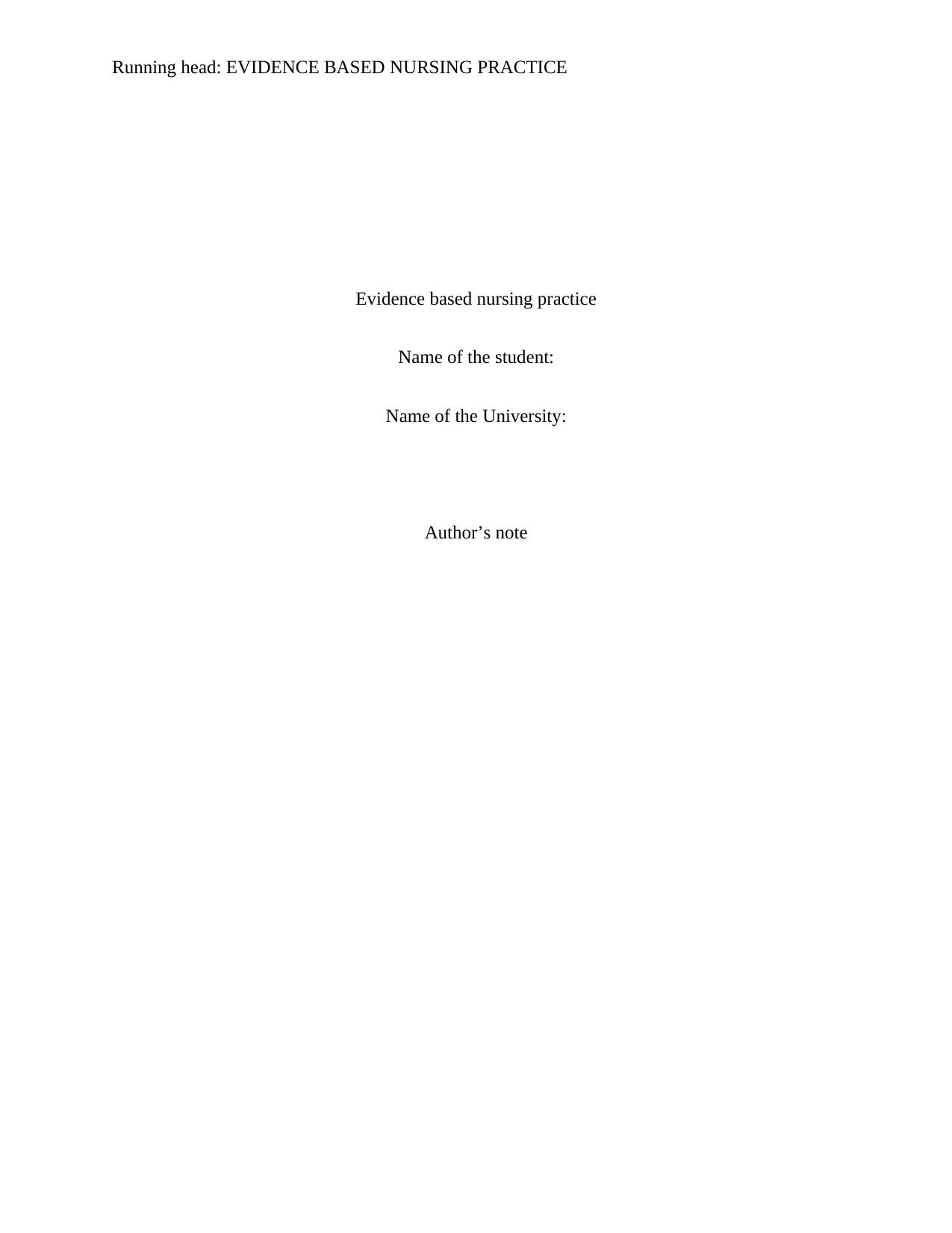
Running head: EVIDENCE BASED NURSING PRACTICE
Evidence based nursing practice
Name of the student:
Name of the University:
Author’s note
Evidence based nursing practice
Name of the student:
Name of the University:
Author’s note
Paraphrase This Document
Need a fresh take? Get an instant paraphrase of this document with our AI Paraphraser
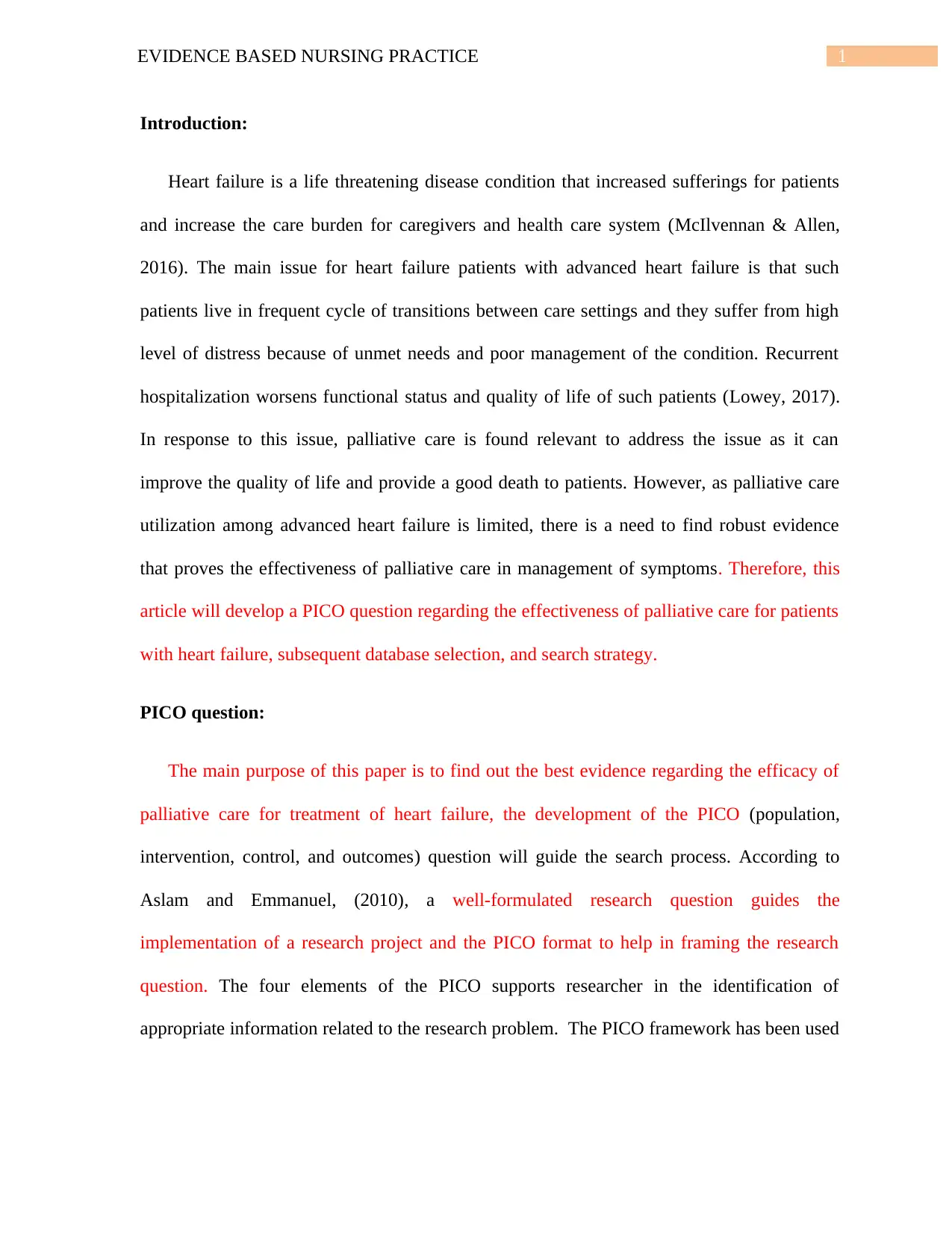
1EVIDENCE BASED NURSING PRACTICE
Introduction:
Heart failure is a life threatening disease condition that increased sufferings for patients
and increase the care burden for caregivers and health care system (McIlvennan & Allen,
2016). The main issue for heart failure patients with advanced heart failure is that such
patients live in frequent cycle of transitions between care settings and they suffer from high
level of distress because of unmet needs and poor management of the condition. Recurrent
hospitalization worsens functional status and quality of life of such patients (Lowey, 2017).
In response to this issue, palliative care is found relevant to address the issue as it can
improve the quality of life and provide a good death to patients. However, as palliative care
utilization among advanced heart failure is limited, there is a need to find robust evidence
that proves the effectiveness of palliative care in management of symptoms. Therefore, this
article will develop a PICO question regarding the effectiveness of palliative care for patients
with heart failure, subsequent database selection, and search strategy.
PICO question:
The main purpose of this paper is to find out the best evidence regarding the efficacy of
palliative care for treatment of heart failure, the development of the PICO (population,
intervention, control, and outcomes) question will guide the search process. According to
Aslam and Emmanuel, (2010), a well-formulated research question guides the
implementation of a research project and the PICO format to help in framing the research
question. The four elements of the PICO supports researcher in the identification of
appropriate information related to the research problem. The PICO framework has been used
Introduction:
Heart failure is a life threatening disease condition that increased sufferings for patients
and increase the care burden for caregivers and health care system (McIlvennan & Allen,
2016). The main issue for heart failure patients with advanced heart failure is that such
patients live in frequent cycle of transitions between care settings and they suffer from high
level of distress because of unmet needs and poor management of the condition. Recurrent
hospitalization worsens functional status and quality of life of such patients (Lowey, 2017).
In response to this issue, palliative care is found relevant to address the issue as it can
improve the quality of life and provide a good death to patients. However, as palliative care
utilization among advanced heart failure is limited, there is a need to find robust evidence
that proves the effectiveness of palliative care in management of symptoms. Therefore, this
article will develop a PICO question regarding the effectiveness of palliative care for patients
with heart failure, subsequent database selection, and search strategy.
PICO question:
The main purpose of this paper is to find out the best evidence regarding the efficacy of
palliative care for treatment of heart failure, the development of the PICO (population,
intervention, control, and outcomes) question will guide the search process. According to
Aslam and Emmanuel, (2010), a well-formulated research question guides the
implementation of a research project and the PICO format to help in framing the research
question. The four elements of the PICO supports researcher in the identification of
appropriate information related to the research problem. The PICO framework has been used
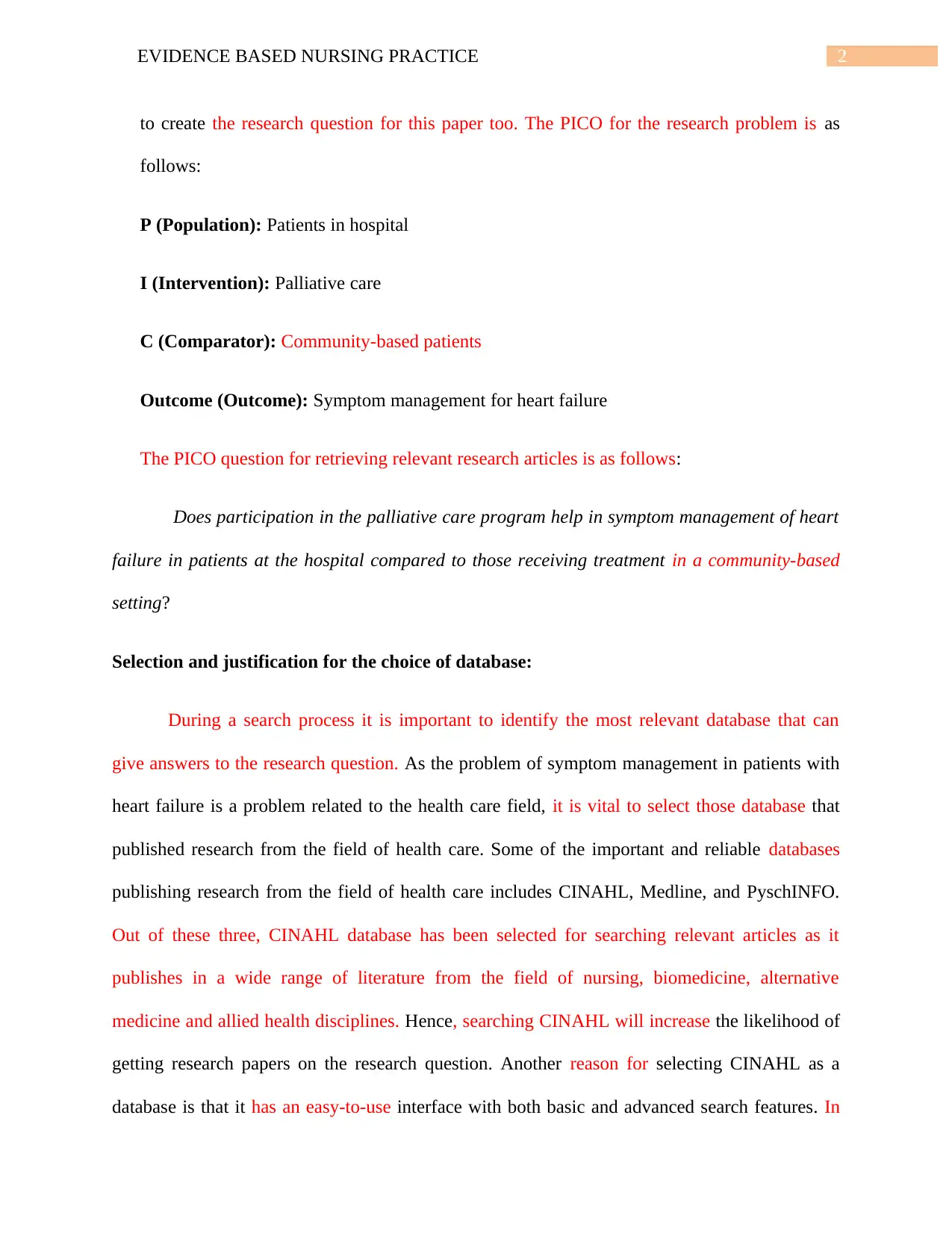
2EVIDENCE BASED NURSING PRACTICE
to create the research question for this paper too. The PICO for the research problem is as
follows:
P (Population): Patients in hospital
I (Intervention): Palliative care
C (Comparator): Community-based patients
Outcome (Outcome): Symptom management for heart failure
The PICO question for retrieving relevant research articles is as follows:
Does participation in the palliative care program help in symptom management of heart
failure in patients at the hospital compared to those receiving treatment in a community-based
setting?
Selection and justification for the choice of database:
During a search process it is important to identify the most relevant database that can
give answers to the research question. As the problem of symptom management in patients with
heart failure is a problem related to the health care field, it is vital to select those database that
published research from the field of health care. Some of the important and reliable databases
publishing research from the field of health care includes CINAHL, Medline, and PyschINFO.
Out of these three, CINAHL database has been selected for searching relevant articles as it
publishes in a wide range of literature from the field of nursing, biomedicine, alternative
medicine and allied health disciplines. Hence, searching CINAHL will increase the likelihood of
getting research papers on the research question. Another reason for selecting CINAHL as a
database is that it has an easy-to-use interface with both basic and advanced search features. In
to create the research question for this paper too. The PICO for the research problem is as
follows:
P (Population): Patients in hospital
I (Intervention): Palliative care
C (Comparator): Community-based patients
Outcome (Outcome): Symptom management for heart failure
The PICO question for retrieving relevant research articles is as follows:
Does participation in the palliative care program help in symptom management of heart
failure in patients at the hospital compared to those receiving treatment in a community-based
setting?
Selection and justification for the choice of database:
During a search process it is important to identify the most relevant database that can
give answers to the research question. As the problem of symptom management in patients with
heart failure is a problem related to the health care field, it is vital to select those database that
published research from the field of health care. Some of the important and reliable databases
publishing research from the field of health care includes CINAHL, Medline, and PyschINFO.
Out of these three, CINAHL database has been selected for searching relevant articles as it
publishes in a wide range of literature from the field of nursing, biomedicine, alternative
medicine and allied health disciplines. Hence, searching CINAHL will increase the likelihood of
getting research papers on the research question. Another reason for selecting CINAHL as a
database is that it has an easy-to-use interface with both basic and advanced search features. In
⊘ This is a preview!⊘
Do you want full access?
Subscribe today to unlock all pages.

Trusted by 1+ million students worldwide
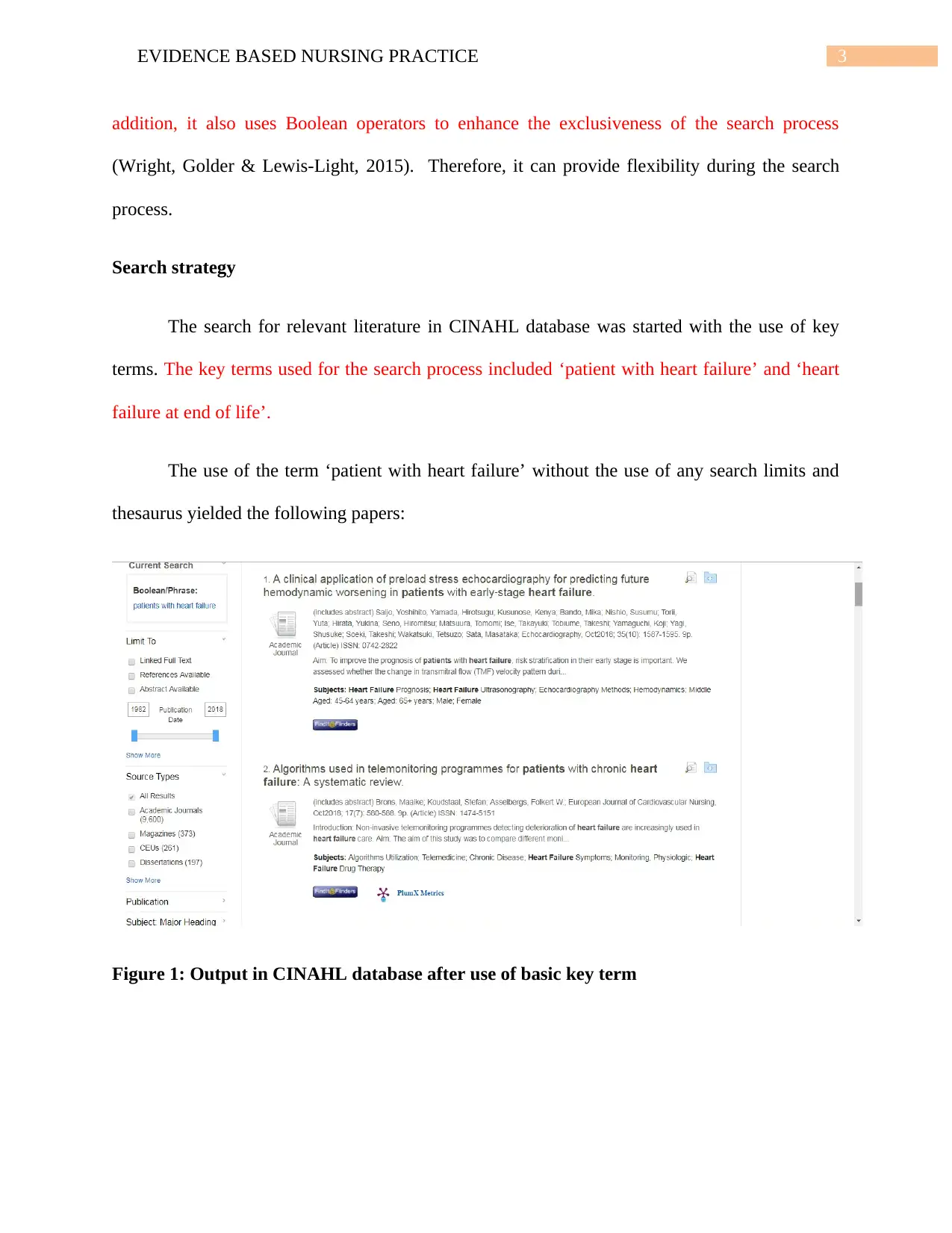
3EVIDENCE BASED NURSING PRACTICE
addition, it also uses Boolean operators to enhance the exclusiveness of the search process
(Wright, Golder & Lewis-Light, 2015). Therefore, it can provide flexibility during the search
process.
Search strategy
The search for relevant literature in CINAHL database was started with the use of key
terms. The key terms used for the search process included ‘patient with heart failure’ and ‘heart
failure at end of life’.
The use of the term ‘patient with heart failure’ without the use of any search limits and
thesaurus yielded the following papers:
Figure 1: Output in CINAHL database after use of basic key term
addition, it also uses Boolean operators to enhance the exclusiveness of the search process
(Wright, Golder & Lewis-Light, 2015). Therefore, it can provide flexibility during the search
process.
Search strategy
The search for relevant literature in CINAHL database was started with the use of key
terms. The key terms used for the search process included ‘patient with heart failure’ and ‘heart
failure at end of life’.
The use of the term ‘patient with heart failure’ without the use of any search limits and
thesaurus yielded the following papers:
Figure 1: Output in CINAHL database after use of basic key term
Paraphrase This Document
Need a fresh take? Get an instant paraphrase of this document with our AI Paraphraser
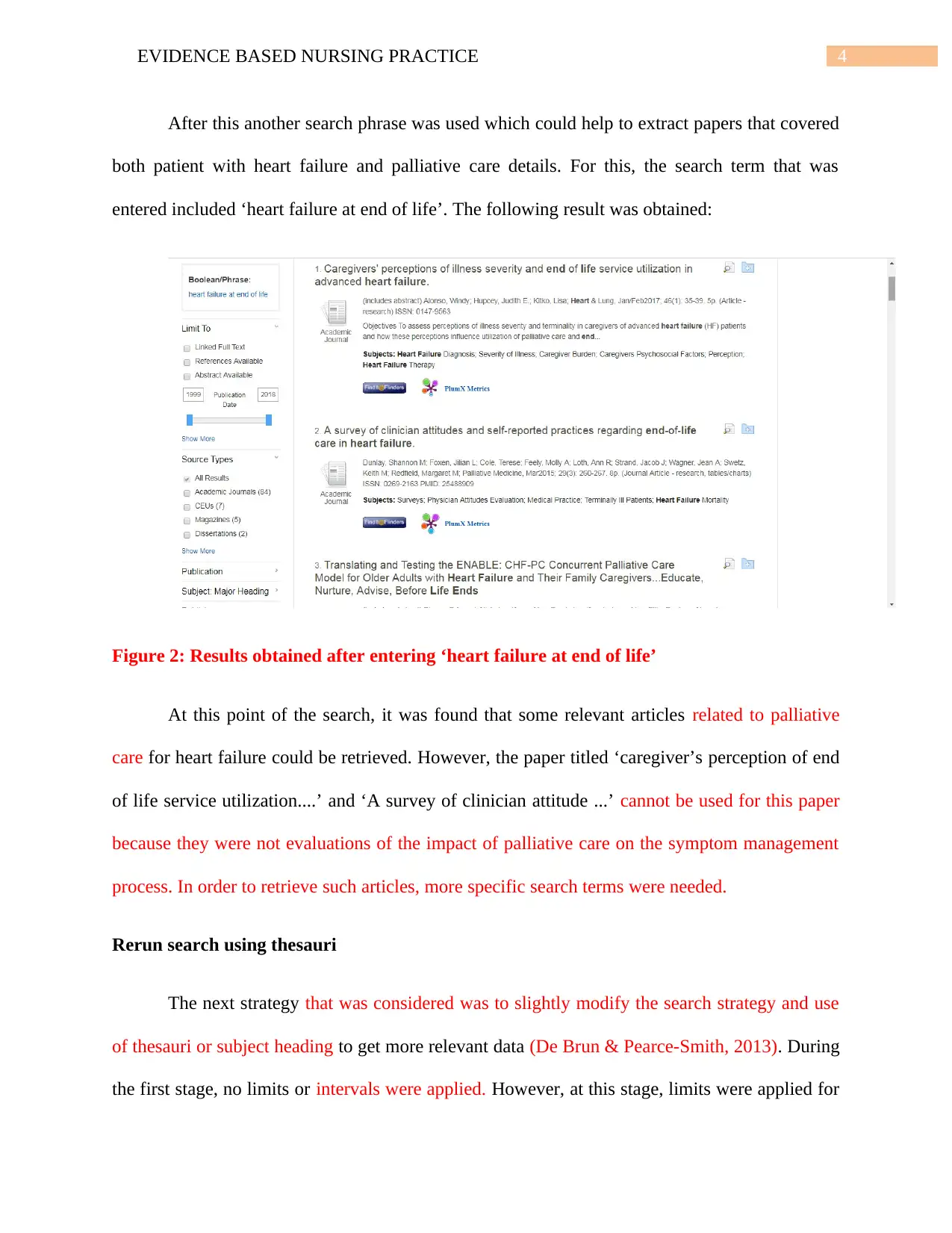
4EVIDENCE BASED NURSING PRACTICE
After this another search phrase was used which could help to extract papers that covered
both patient with heart failure and palliative care details. For this, the search term that was
entered included ‘heart failure at end of life’. The following result was obtained:
Figure 2: Results obtained after entering ‘heart failure at end of life’
At this point of the search, it was found that some relevant articles related to palliative
care for heart failure could be retrieved. However, the paper titled ‘caregiver’s perception of end
of life service utilization....’ and ‘A survey of clinician attitude ...’ cannot be used for this paper
because they were not evaluations of the impact of palliative care on the symptom management
process. In order to retrieve such articles, more specific search terms were needed.
Rerun search using thesauri
The next strategy that was considered was to slightly modify the search strategy and use
of thesauri or subject heading to get more relevant data (De Brun & Pearce-Smith, 2013). During
the first stage, no limits or intervals were applied. However, at this stage, limits were applied for
After this another search phrase was used which could help to extract papers that covered
both patient with heart failure and palliative care details. For this, the search term that was
entered included ‘heart failure at end of life’. The following result was obtained:
Figure 2: Results obtained after entering ‘heart failure at end of life’
At this point of the search, it was found that some relevant articles related to palliative
care for heart failure could be retrieved. However, the paper titled ‘caregiver’s perception of end
of life service utilization....’ and ‘A survey of clinician attitude ...’ cannot be used for this paper
because they were not evaluations of the impact of palliative care on the symptom management
process. In order to retrieve such articles, more specific search terms were needed.
Rerun search using thesauri
The next strategy that was considered was to slightly modify the search strategy and use
of thesauri or subject heading to get more relevant data (De Brun & Pearce-Smith, 2013). During
the first stage, no limits or intervals were applied. However, at this stage, limits were applied for
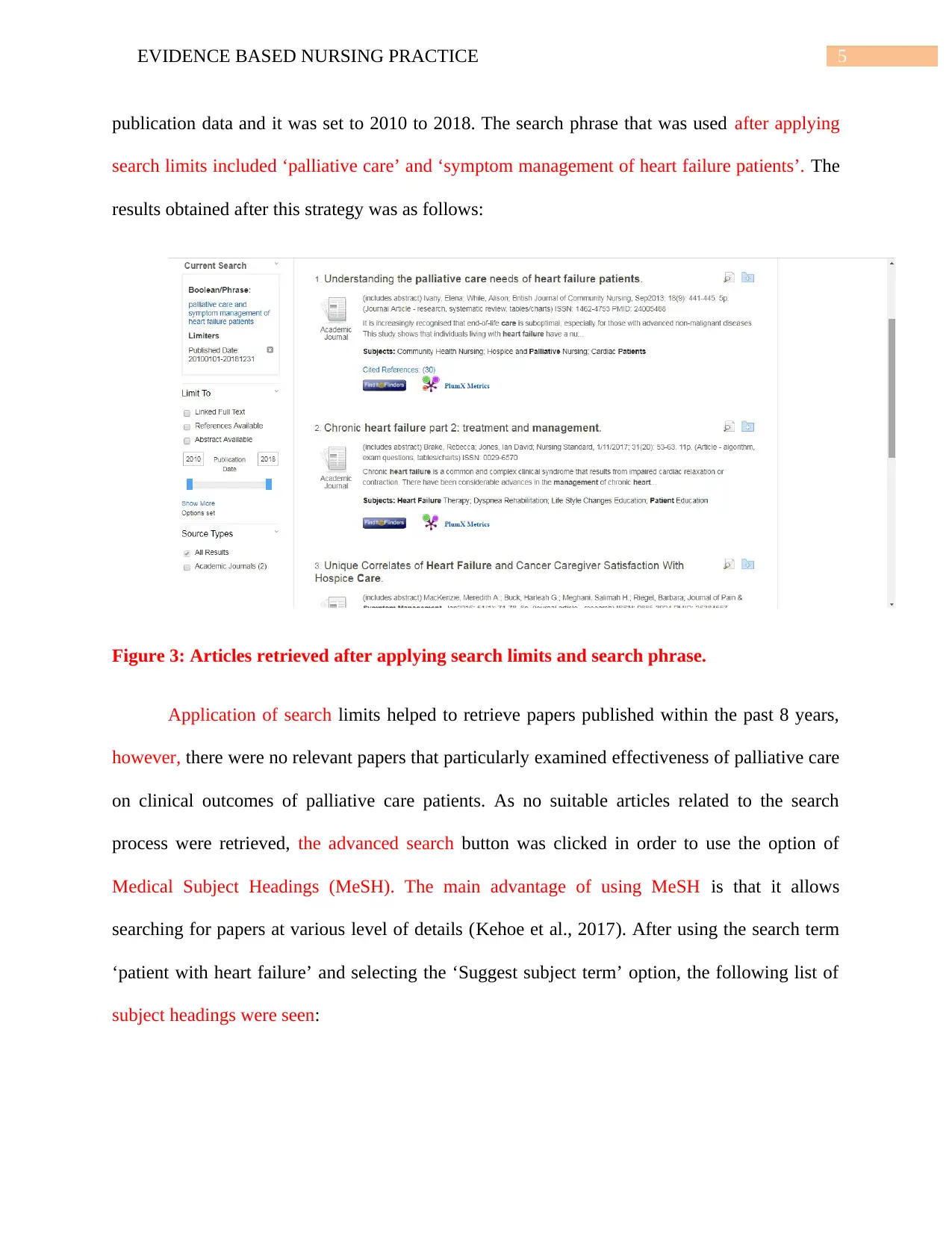
5EVIDENCE BASED NURSING PRACTICE
publication data and it was set to 2010 to 2018. The search phrase that was used after applying
search limits included ‘palliative care’ and ‘symptom management of heart failure patients’. The
results obtained after this strategy was as follows:
Figure 3: Articles retrieved after applying search limits and search phrase.
Application of search limits helped to retrieve papers published within the past 8 years,
however, there were no relevant papers that particularly examined effectiveness of palliative care
on clinical outcomes of palliative care patients. As no suitable articles related to the search
process were retrieved, the advanced search button was clicked in order to use the option of
Medical Subject Headings (MeSH). The main advantage of using MeSH is that it allows
searching for papers at various level of details (Kehoe et al., 2017). After using the search term
‘patient with heart failure’ and selecting the ‘Suggest subject term’ option, the following list of
subject headings were seen:
publication data and it was set to 2010 to 2018. The search phrase that was used after applying
search limits included ‘palliative care’ and ‘symptom management of heart failure patients’. The
results obtained after this strategy was as follows:
Figure 3: Articles retrieved after applying search limits and search phrase.
Application of search limits helped to retrieve papers published within the past 8 years,
however, there were no relevant papers that particularly examined effectiveness of palliative care
on clinical outcomes of palliative care patients. As no suitable articles related to the search
process were retrieved, the advanced search button was clicked in order to use the option of
Medical Subject Headings (MeSH). The main advantage of using MeSH is that it allows
searching for papers at various level of details (Kehoe et al., 2017). After using the search term
‘patient with heart failure’ and selecting the ‘Suggest subject term’ option, the following list of
subject headings were seen:
⊘ This is a preview!⊘
Do you want full access?
Subscribe today to unlock all pages.

Trusted by 1+ million students worldwide
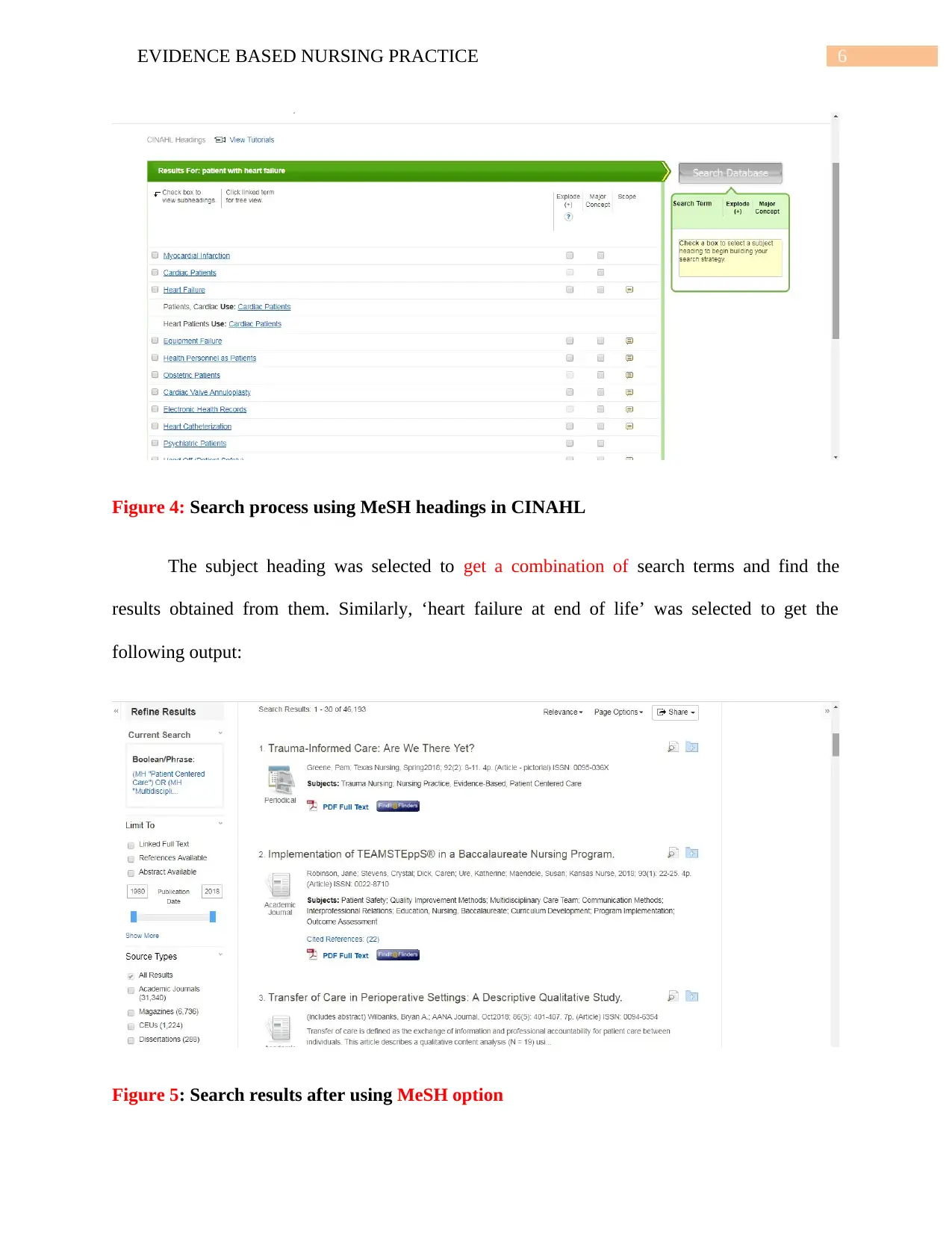
6EVIDENCE BASED NURSING PRACTICE
Figure 4: Search process using MeSH headings in CINAHL
The subject heading was selected to get a combination of search terms and find the
results obtained from them. Similarly, ‘heart failure at end of life’ was selected to get the
following output:
Figure 5: Search results after using MeSH option
Figure 4: Search process using MeSH headings in CINAHL
The subject heading was selected to get a combination of search terms and find the
results obtained from them. Similarly, ‘heart failure at end of life’ was selected to get the
following output:
Figure 5: Search results after using MeSH option
Paraphrase This Document
Need a fresh take? Get an instant paraphrase of this document with our AI Paraphraser
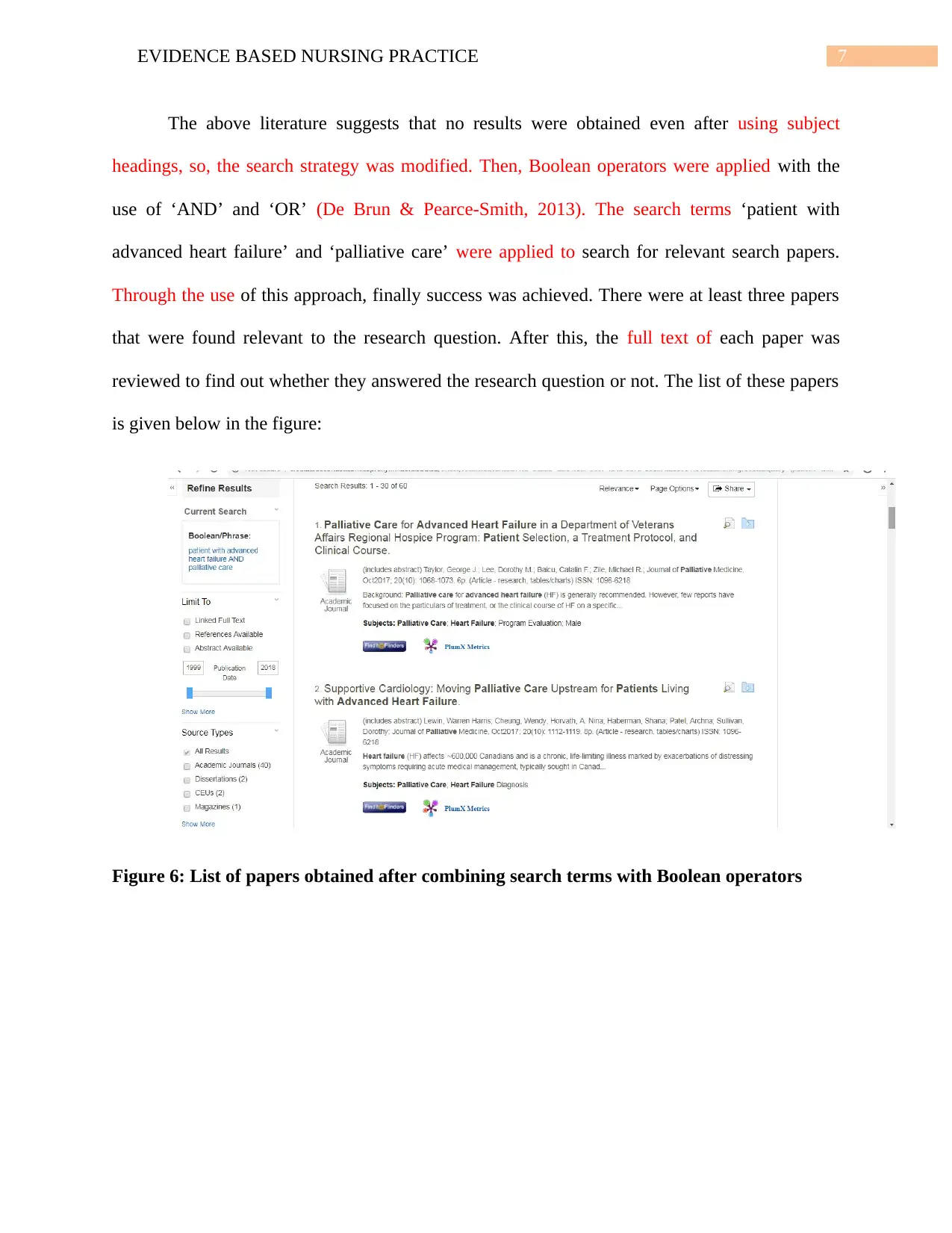
7EVIDENCE BASED NURSING PRACTICE
The above literature suggests that no results were obtained even after using subject
headings, so, the search strategy was modified. Then, Boolean operators were applied with the
use of ‘AND’ and ‘OR’ (De Brun & Pearce-Smith, 2013). The search terms ‘patient with
advanced heart failure’ and ‘palliative care’ were applied to search for relevant search papers.
Through the use of this approach, finally success was achieved. There were at least three papers
that were found relevant to the research question. After this, the full text of each paper was
reviewed to find out whether they answered the research question or not. The list of these papers
is given below in the figure:
Figure 6: List of papers obtained after combining search terms with Boolean operators
The above literature suggests that no results were obtained even after using subject
headings, so, the search strategy was modified. Then, Boolean operators were applied with the
use of ‘AND’ and ‘OR’ (De Brun & Pearce-Smith, 2013). The search terms ‘patient with
advanced heart failure’ and ‘palliative care’ were applied to search for relevant search papers.
Through the use of this approach, finally success was achieved. There were at least three papers
that were found relevant to the research question. After this, the full text of each paper was
reviewed to find out whether they answered the research question or not. The list of these papers
is given below in the figure:
Figure 6: List of papers obtained after combining search terms with Boolean operators
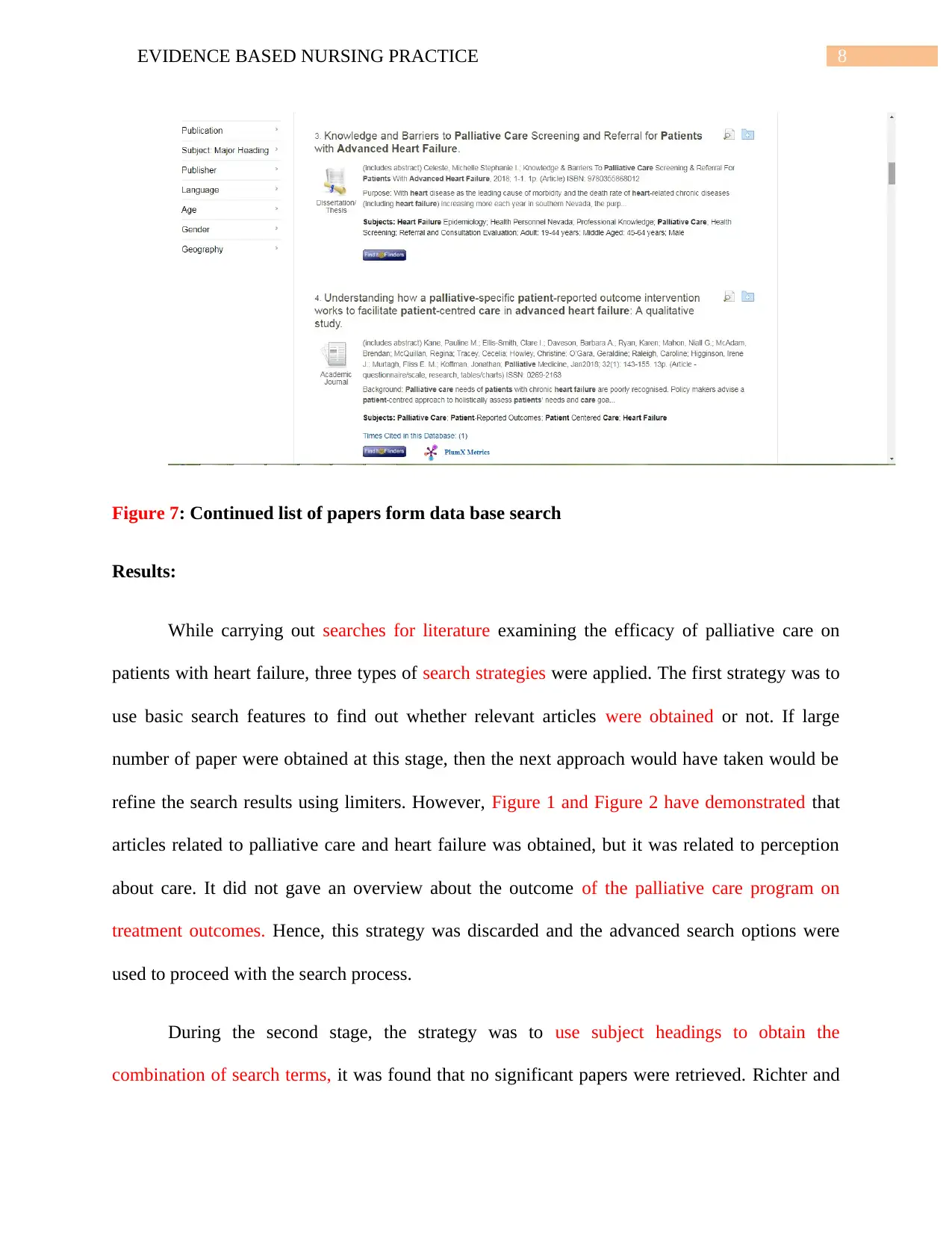
8EVIDENCE BASED NURSING PRACTICE
Figure 7: Continued list of papers form data base search
Results:
While carrying out searches for literature examining the efficacy of palliative care on
patients with heart failure, three types of search strategies were applied. The first strategy was to
use basic search features to find out whether relevant articles were obtained or not. If large
number of paper were obtained at this stage, then the next approach would have taken would be
refine the search results using limiters. However, Figure 1 and Figure 2 have demonstrated that
articles related to palliative care and heart failure was obtained, but it was related to perception
about care. It did not gave an overview about the outcome of the palliative care program on
treatment outcomes. Hence, this strategy was discarded and the advanced search options were
used to proceed with the search process.
During the second stage, the strategy was to use subject headings to obtain the
combination of search terms, it was found that no significant papers were retrieved. Richter and
Figure 7: Continued list of papers form data base search
Results:
While carrying out searches for literature examining the efficacy of palliative care on
patients with heart failure, three types of search strategies were applied. The first strategy was to
use basic search features to find out whether relevant articles were obtained or not. If large
number of paper were obtained at this stage, then the next approach would have taken would be
refine the search results using limiters. However, Figure 1 and Figure 2 have demonstrated that
articles related to palliative care and heart failure was obtained, but it was related to perception
about care. It did not gave an overview about the outcome of the palliative care program on
treatment outcomes. Hence, this strategy was discarded and the advanced search options were
used to proceed with the search process.
During the second stage, the strategy was to use subject headings to obtain the
combination of search terms, it was found that no significant papers were retrieved. Richter and
⊘ This is a preview!⊘
Do you want full access?
Subscribe today to unlock all pages.

Trusted by 1+ million students worldwide
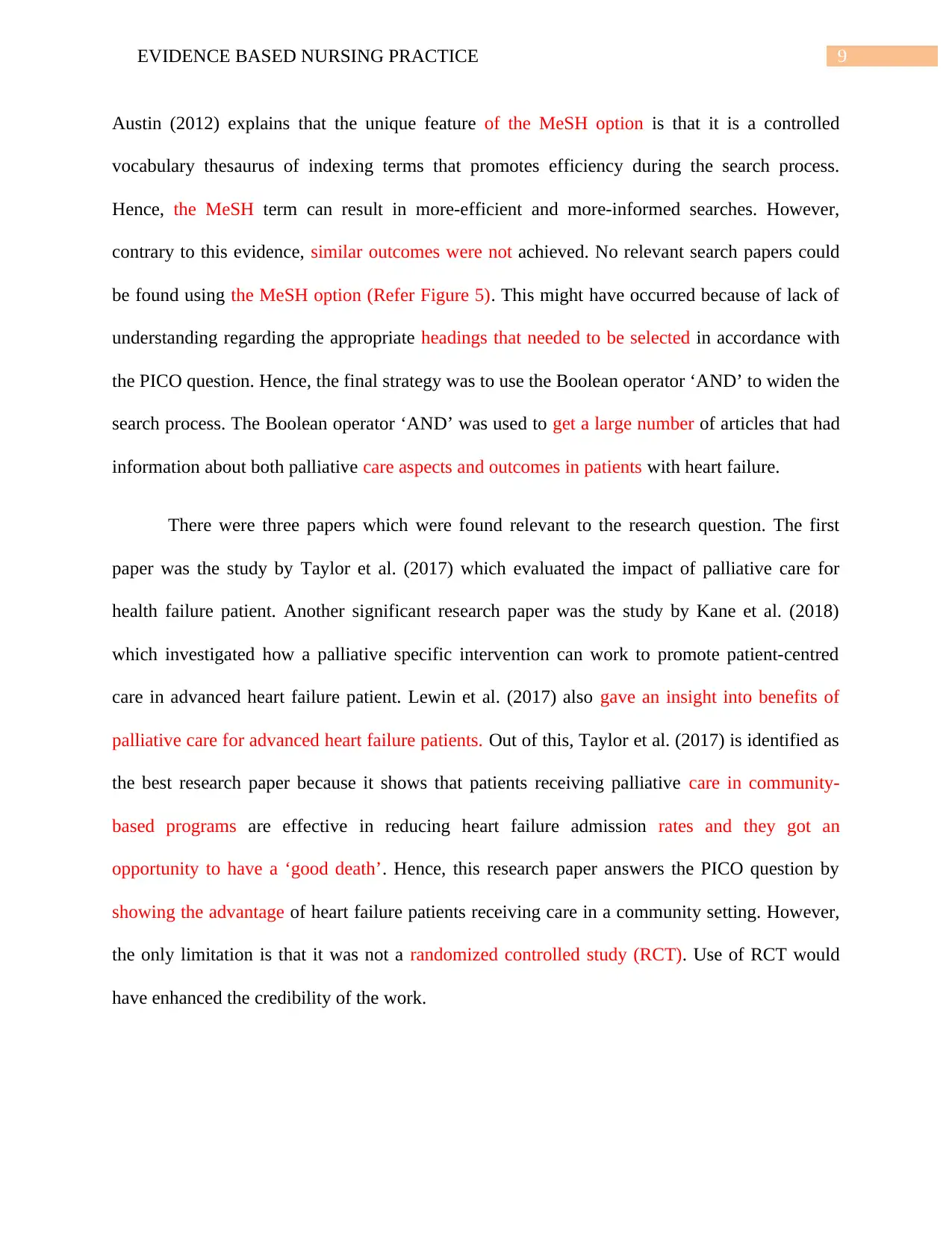
9EVIDENCE BASED NURSING PRACTICE
Austin (2012) explains that the unique feature of the MeSH option is that it is a controlled
vocabulary thesaurus of indexing terms that promotes efficiency during the search process.
Hence, the MeSH term can result in more-efficient and more-informed searches. However,
contrary to this evidence, similar outcomes were not achieved. No relevant search papers could
be found using the MeSH option (Refer Figure 5). This might have occurred because of lack of
understanding regarding the appropriate headings that needed to be selected in accordance with
the PICO question. Hence, the final strategy was to use the Boolean operator ‘AND’ to widen the
search process. The Boolean operator ‘AND’ was used to get a large number of articles that had
information about both palliative care aspects and outcomes in patients with heart failure.
There were three papers which were found relevant to the research question. The first
paper was the study by Taylor et al. (2017) which evaluated the impact of palliative care for
health failure patient. Another significant research paper was the study by Kane et al. (2018)
which investigated how a palliative specific intervention can work to promote patient-centred
care in advanced heart failure patient. Lewin et al. (2017) also gave an insight into benefits of
palliative care for advanced heart failure patients. Out of this, Taylor et al. (2017) is identified as
the best research paper because it shows that patients receiving palliative care in community-
based programs are effective in reducing heart failure admission rates and they got an
opportunity to have a ‘good death’. Hence, this research paper answers the PICO question by
showing the advantage of heart failure patients receiving care in a community setting. However,
the only limitation is that it was not a randomized controlled study (RCT). Use of RCT would
have enhanced the credibility of the work.
Austin (2012) explains that the unique feature of the MeSH option is that it is a controlled
vocabulary thesaurus of indexing terms that promotes efficiency during the search process.
Hence, the MeSH term can result in more-efficient and more-informed searches. However,
contrary to this evidence, similar outcomes were not achieved. No relevant search papers could
be found using the MeSH option (Refer Figure 5). This might have occurred because of lack of
understanding regarding the appropriate headings that needed to be selected in accordance with
the PICO question. Hence, the final strategy was to use the Boolean operator ‘AND’ to widen the
search process. The Boolean operator ‘AND’ was used to get a large number of articles that had
information about both palliative care aspects and outcomes in patients with heart failure.
There were three papers which were found relevant to the research question. The first
paper was the study by Taylor et al. (2017) which evaluated the impact of palliative care for
health failure patient. Another significant research paper was the study by Kane et al. (2018)
which investigated how a palliative specific intervention can work to promote patient-centred
care in advanced heart failure patient. Lewin et al. (2017) also gave an insight into benefits of
palliative care for advanced heart failure patients. Out of this, Taylor et al. (2017) is identified as
the best research paper because it shows that patients receiving palliative care in community-
based programs are effective in reducing heart failure admission rates and they got an
opportunity to have a ‘good death’. Hence, this research paper answers the PICO question by
showing the advantage of heart failure patients receiving care in a community setting. However,
the only limitation is that it was not a randomized controlled study (RCT). Use of RCT would
have enhanced the credibility of the work.
Paraphrase This Document
Need a fresh take? Get an instant paraphrase of this document with our AI Paraphraser
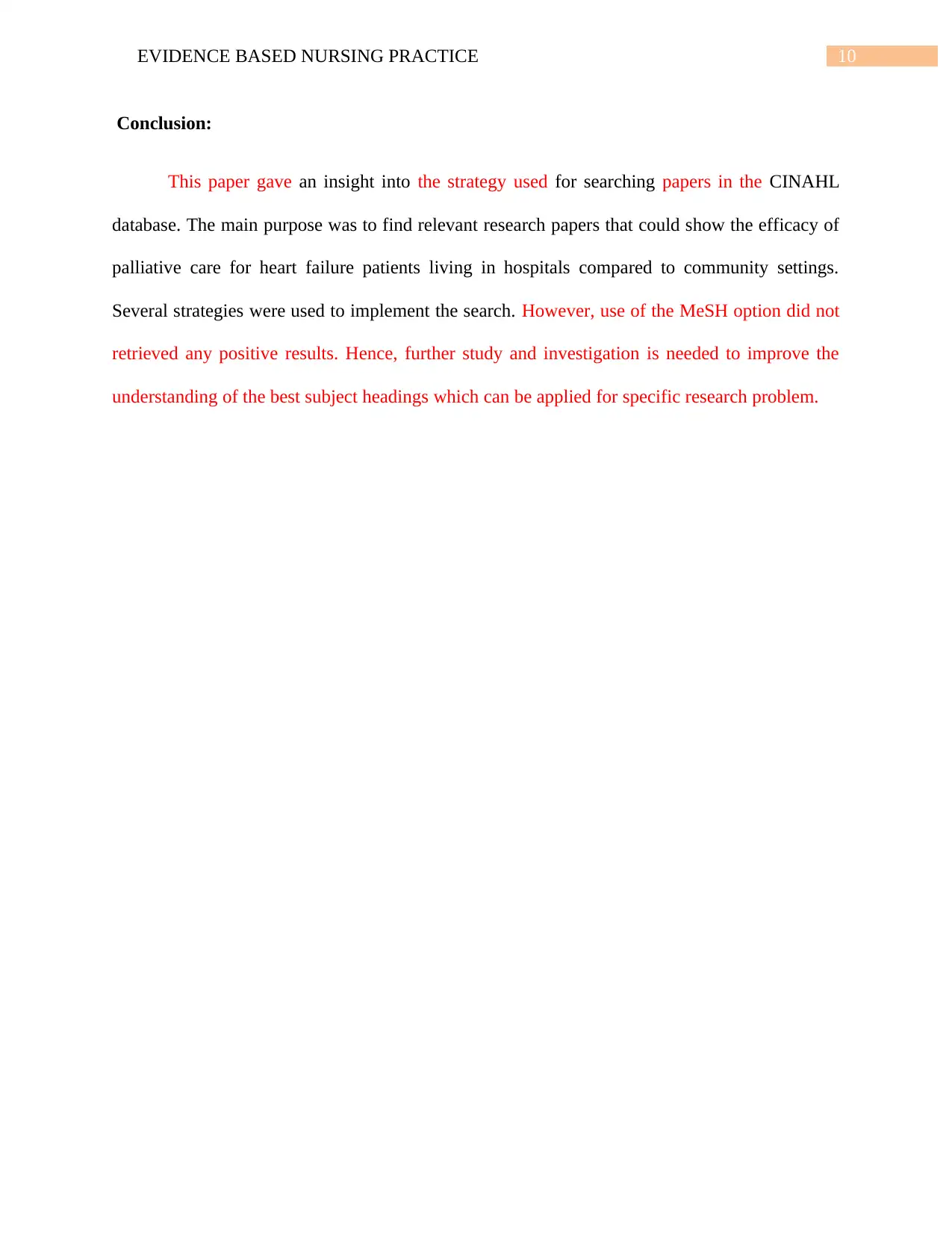
10EVIDENCE BASED NURSING PRACTICE
Conclusion:
This paper gave an insight into the strategy used for searching papers in the CINAHL
database. The main purpose was to find relevant research papers that could show the efficacy of
palliative care for heart failure patients living in hospitals compared to community settings.
Several strategies were used to implement the search. However, use of the MeSH option did not
retrieved any positive results. Hence, further study and investigation is needed to improve the
understanding of the best subject headings which can be applied for specific research problem.
Conclusion:
This paper gave an insight into the strategy used for searching papers in the CINAHL
database. The main purpose was to find relevant research papers that could show the efficacy of
palliative care for heart failure patients living in hospitals compared to community settings.
Several strategies were used to implement the search. However, use of the MeSH option did not
retrieved any positive results. Hence, further study and investigation is needed to improve the
understanding of the best subject headings which can be applied for specific research problem.
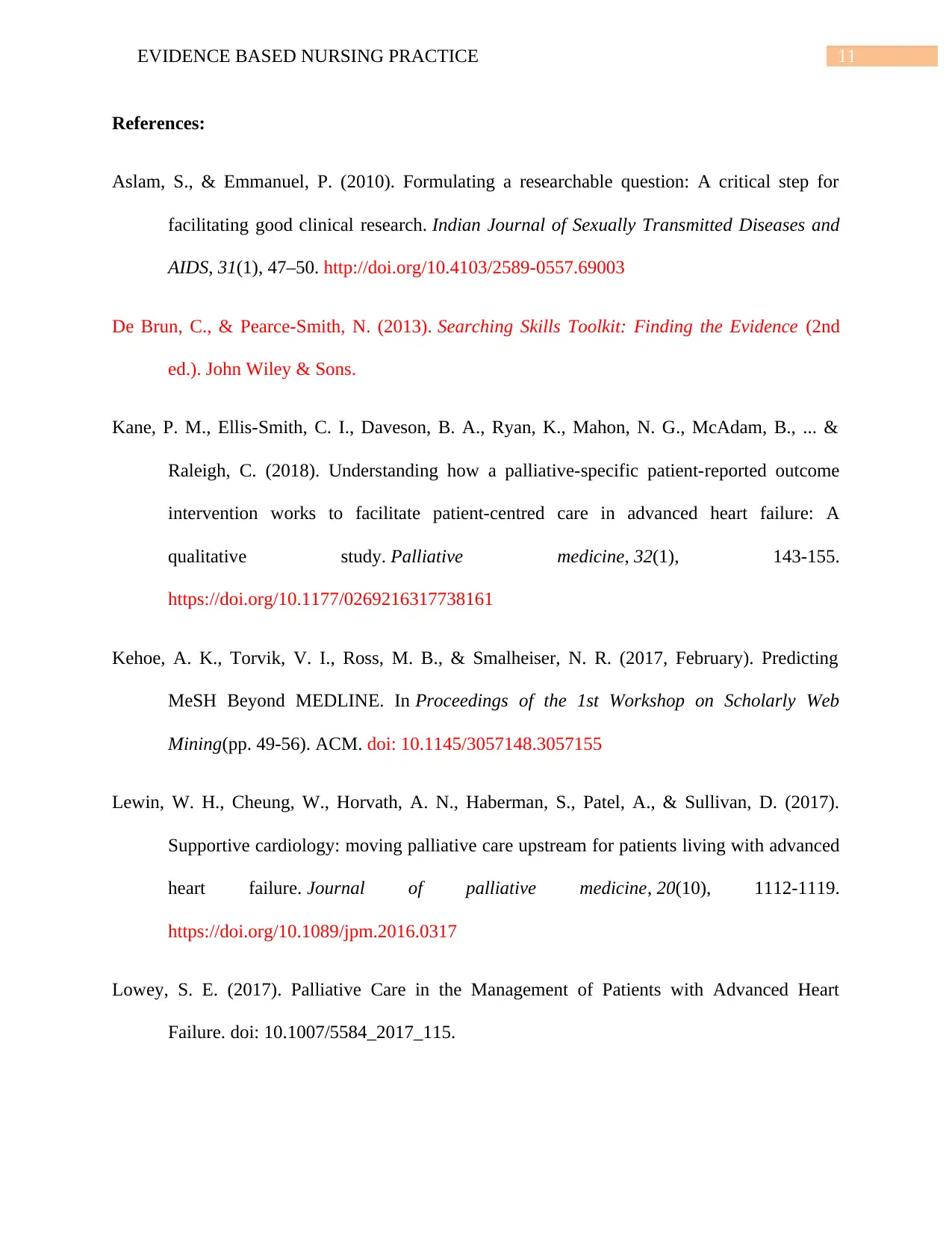
11EVIDENCE BASED NURSING PRACTICE
References:
Aslam, S., & Emmanuel, P. (2010). Formulating a researchable question: A critical step for
facilitating good clinical research. Indian Journal of Sexually Transmitted Diseases and
AIDS, 31(1), 47–50. http://doi.org/10.4103/2589-0557.69003
De Brun, C., & Pearce-Smith, N. (2013). Searching Skills Toolkit: Finding the Evidence (2nd
ed.). John Wiley & Sons.
Kane, P. M., Ellis-Smith, C. I., Daveson, B. A., Ryan, K., Mahon, N. G., McAdam, B., ... &
Raleigh, C. (2018). Understanding how a palliative-specific patient-reported outcome
intervention works to facilitate patient-centred care in advanced heart failure: A
qualitative study. Palliative medicine, 32(1), 143-155.
https://doi.org/10.1177/0269216317738161
Kehoe, A. K., Torvik, V. I., Ross, M. B., & Smalheiser, N. R. (2017, February). Predicting
MeSH Beyond MEDLINE. In Proceedings of the 1st Workshop on Scholarly Web
Mining(pp. 49-56). ACM. doi: 10.1145/3057148.3057155
Lewin, W. H., Cheung, W., Horvath, A. N., Haberman, S., Patel, A., & Sullivan, D. (2017).
Supportive cardiology: moving palliative care upstream for patients living with advanced
heart failure. Journal of palliative medicine, 20(10), 1112-1119.
https://doi.org/10.1089/jpm.2016.0317
Lowey, S. E. (2017). Palliative Care in the Management of Patients with Advanced Heart
Failure. doi: 10.1007/5584_2017_115.
References:
Aslam, S., & Emmanuel, P. (2010). Formulating a researchable question: A critical step for
facilitating good clinical research. Indian Journal of Sexually Transmitted Diseases and
AIDS, 31(1), 47–50. http://doi.org/10.4103/2589-0557.69003
De Brun, C., & Pearce-Smith, N. (2013). Searching Skills Toolkit: Finding the Evidence (2nd
ed.). John Wiley & Sons.
Kane, P. M., Ellis-Smith, C. I., Daveson, B. A., Ryan, K., Mahon, N. G., McAdam, B., ... &
Raleigh, C. (2018). Understanding how a palliative-specific patient-reported outcome
intervention works to facilitate patient-centred care in advanced heart failure: A
qualitative study. Palliative medicine, 32(1), 143-155.
https://doi.org/10.1177/0269216317738161
Kehoe, A. K., Torvik, V. I., Ross, M. B., & Smalheiser, N. R. (2017, February). Predicting
MeSH Beyond MEDLINE. In Proceedings of the 1st Workshop on Scholarly Web
Mining(pp. 49-56). ACM. doi: 10.1145/3057148.3057155
Lewin, W. H., Cheung, W., Horvath, A. N., Haberman, S., Patel, A., & Sullivan, D. (2017).
Supportive cardiology: moving palliative care upstream for patients living with advanced
heart failure. Journal of palliative medicine, 20(10), 1112-1119.
https://doi.org/10.1089/jpm.2016.0317
Lowey, S. E. (2017). Palliative Care in the Management of Patients with Advanced Heart
Failure. doi: 10.1007/5584_2017_115.
⊘ This is a preview!⊘
Do you want full access?
Subscribe today to unlock all pages.

Trusted by 1+ million students worldwide
1 out of 13
Related Documents
Your All-in-One AI-Powered Toolkit for Academic Success.
+13062052269
info@desklib.com
Available 24*7 on WhatsApp / Email
![[object Object]](/_next/static/media/star-bottom.7253800d.svg)
Unlock your academic potential
Copyright © 2020–2025 A2Z Services. All Rights Reserved. Developed and managed by ZUCOL.





